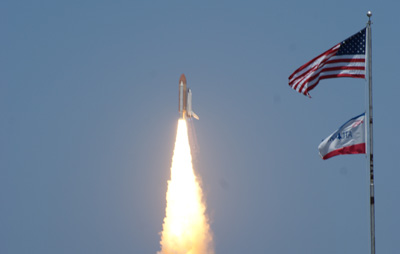The irreplaceable Space Shuttleby Taylor Dinerman
|
| Belief in their own hype led NASA’s leaders to make unrealistic assumptions about what the agency could and could not do. |
Many in the space industry consider the Space Shuttle to have been a major failure. Many experts see the whole program as a waste of time, money, and worst of all, of fourteen precious lives in two major accidents in 1986 and 2003. The shuttle certainly never lived up to the 1970s-era hype that promised that it would become the DC-3 of space. In the 1930s, the DC-3 made commercial airline travel safe and economically viable. The shuttle was supposed to do the same for spaceflight. It would fly as often as once a week and radically reduce the cost of getting into orbit. By this standard it failed miserably.
Belief in their own hype led NASA’s leaders to make unrealistic assumptions about what the agency could and could not do. In turn this resulted in science and technology programs that were delayed, over budget, and, all too often, canceled. Over the decades the damage done to the credibility of the space agency has been devastating.
NASA’s reputation was built on the success of the Apollo Moon missions that from 1969 to 1972 landed 12 men on the Moon. It was not easy and it cost a fortune, but the US space agency did the job and beat the Russians. By the time of the first Moon landing, budget pressures and a lack of political will forced NASA to cancel almost all its plans for future space exploration. There were to be no trips to Mars, and no long-term presence on the Moon.
However, the Nixon administration decided that it could not, in effect, “ground the astronauts” (see “Negative symbolism, or why America will continue to fly astronauts”, The Space Review, January 16, 2006). The Space Shuttle emerged as the cheapest and, theoretically, the most practical way to keep the manned space program alive.
The decision to build the shuttle was announced by President Nixon in January 1972. The plan was to spend more than $13 billion on the project. This was soon cut to less than $6 billion, forcing NASA to cut corners in ways that made it impossible to meet the initial goals. This also forced NASA to bring the Air Force into the program and to modify the design so the spacecraft could fulfill military requirements.
In spite of all the handicaps the shuttle finally flew in 1981. Since then it has successfully flown 132 missions. Hundreds of men and women have flown on it and it has been instrumental in building the International Space Station (ISS). Its versatility made it the NASA workhorse, albeit a delicate workhorse.
Before the 2003 Columbia disaster NASA had been planning to update the whole shuttle system and keep it flying until 2025. The agency’s leadership figured that this would give them plenty of time to come up with an acceptable replacement.
| In spite of inadequate budgets, political pressure, and unrealistic public expectations, NASA built an amazing vehicle. |
In 2004, following report of the Columbia Accident Investigation Board, the Bush Administration decided to restore the Space Shuttle to flight status for the limited mission of finishing the ISS. This would fulfill America’s commitment to the other nations in the ISS partnership. After that the plan was to transition to the Constellation program, which would take America back to the Moon. NASA planned to use commercial services to resupply the ISS. The Bush administration left the door open for possible commercial taxi services to the station, but they wanted to wait until the companies involved had proved their capability.
Last year, the Obama administration cancelled the Bush return-to-the-Moon program. They are supposedly committed to building a new Multi-Purpose Crew Vehicle based on the Orion capsule from the Constellation program. Sadly, as the Apollo astronauts Neil Armstrong, Jim Lovell, and Gene Cernan wrote in USA Today, “Congress has mandated the development of rocket launchers and spacecraft to explore the near solar system beyond Earth orbit. But NASA has not yet announced a convincing strategy for their use. After a half century of remarkable progress, a coherent plan for maintaining America’s leadership in space exploration is no longer apparent.”
Now NASA is hoping that the commercial launch industry will provide the US with a way to get its astronauts to and from orbit. The companies involved have made a lot of promises, but are moving slowly and cautiously towards the goal of providing “airliner type service” to space. Some observers, like Armstrong, Lovell, and Cernan, are unconvinced.
The shuttles are headed for museums and for the history books. The debates over what was, or should be, the right space policy will go on. Yet in all the noise and smoke of the arguments the accomplishments of the shuttle program are forgotten.
In spite of inadequate budgets, political pressure, and unrealistic public expectations, NASA built an amazing vehicle. The men and women of America’s space agency and its contractors should be proud of what they managed to do. It’s hard to be optimistic about the future of NASA, but the agency has recovered from past disasters and neglect, and it may do so again.
